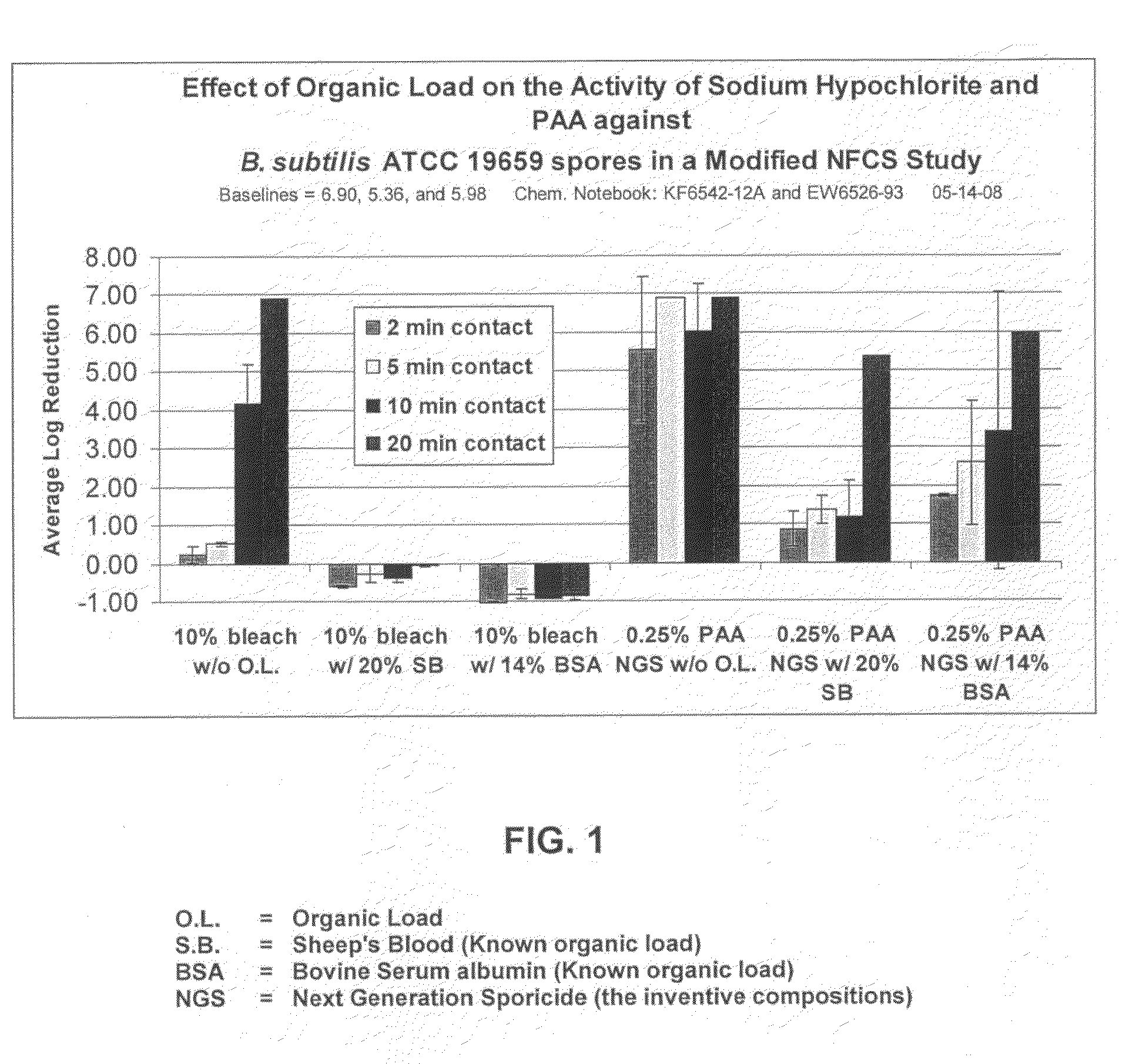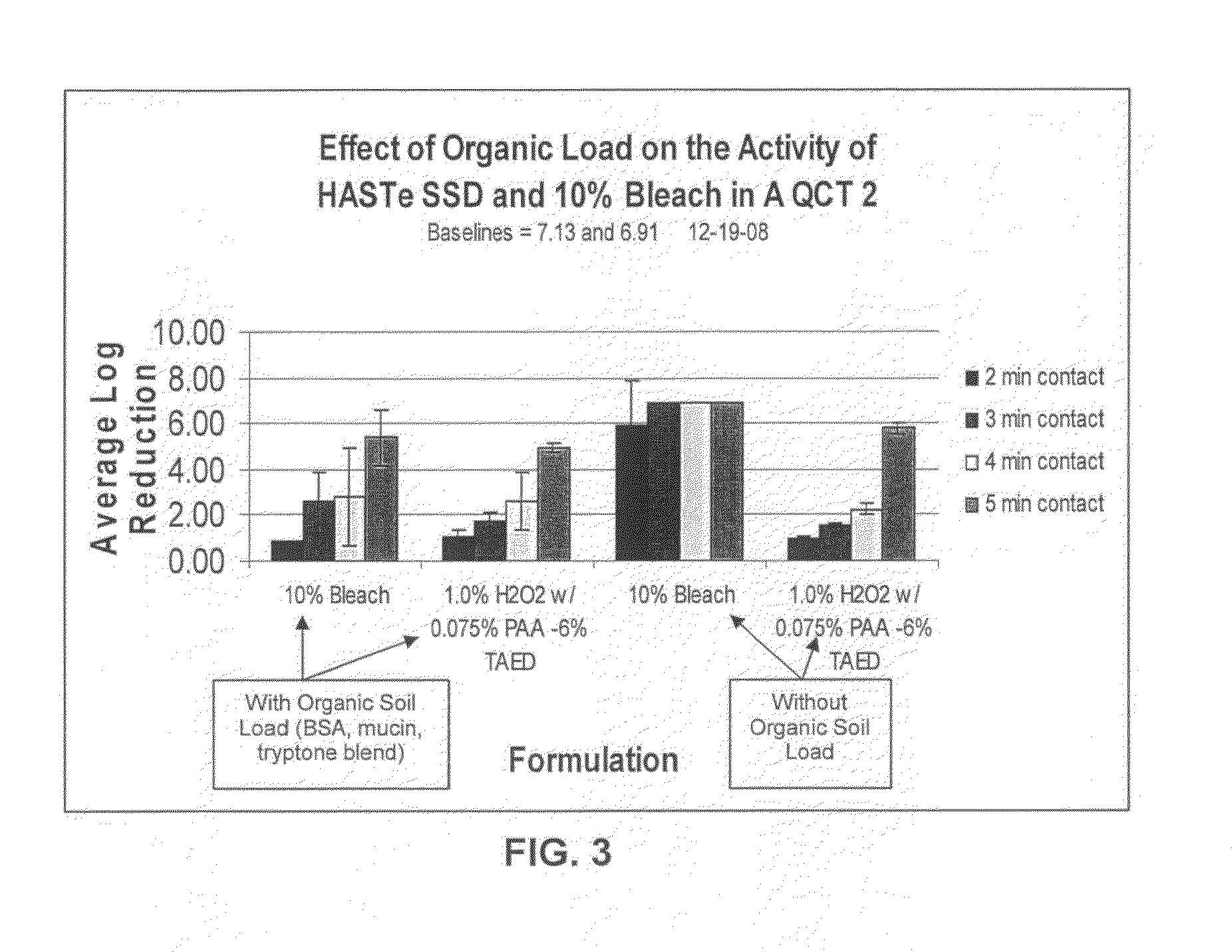Low odor, hard surface sporicide
a sporicide and hard surface technology, applied in the direction of biocide, amide active ingredients, detergent compounding agents, etc., can solve the problems of inherently difficult to destroy, ineffective alcohol-based disinfectants alone against i>c.diff, and life-threatening to many patient populations, etc., to achieve rapid generation of peracetic acid, facilitate handling and transportation
- Summary
- Abstract
- Description
- Claims
- Application Information
AI Technical Summary
Benefits of technology
Problems solved by technology
Method used
Image
Examples
example 1
[0063]Sporicidal efficacy of the two-part liquid activator / formulated hydrogen peroxide system in a modified Non-Food Contact Sanitizer (NFCS) study is shown in FIG. 1. The results show that the inventive formulation, which generated approximately 0.25% peracetic acid, was superior to bleach (1:10 dilution in water) against Bacillus subtilus, a known spore former, in the presence of various organic loads and varying contact times. Bacillus subtilus, ATCC 19659 is useful as a surrogate for spore forming bacteria, such as anthrax, among others.
example 2
[0064]Sporicidal efficacy of the inventive compositions was tested, using the Quantitative Carrier Test 2 (QCT-2) method against C.diff spores. The inventive composition shown in Table III was tested at various concentrations and mixed as indicated below.
TABLE IIIDry TAED ActivatorIngredientFunctionAmount (wt. %)TetraacetylethylenediamineActive Ingredient63.58%(TAED)Alkyldiphenyl OxideAnionic Surfactant / 11.49%DisulfonateDispersant(Dowfax C10L - 45%active (aq))Tetrasodium IminodisuccinateChelating Agent / 22.26%Alkalinity SourceSodium CarbonateAlkalinity Source / 2.67%BufferFormulated Liquid Hydrogen PeroxideIngredientFunctionConcentration35% Hydrogen Peroxide (aq)Active Ingredient2.86%Deionized Water—96.79%Poloxamer 407Nonionic Surfactant0.05%FragranceFragrance0.30%
Dilutions:
[0065]To generate 0.050% peracetic acid, 0.225 grams of the dry TAED activator was added to 200 mL of the formulated hydrogen peroxide.[0066]To generate 0.75% peracetic acid, 0.337 grams of the dry TAED acti...
example 3
Effect of Soil Load
[0074]The effect of organic soil load on average log reduction using QCT-2 testing was also evaluated. The formulation used is set forth in Table IV below.
TABLE IVDry TAED ActivatorIngredientFunctionAmountTetraacetylethylenediamineActive Ingredient0.2757 grams(TAED)Alkyldiphenyl OxideAnionic Surfactant / 0.0498 gramsDisulfonateDispersant(Dowfax C10L - 45%active (aq))Tetrasodium IminodisuccinateChelating Agent / 0.1107 gramsAlkalinity SourceSodium CarbonateAlkalinity Source / Buffer0.0133 gramsPolyvinyl Alcohol Film*Film Material0.0792 gramsFormulated Liquid Hydrogen PeroxideConcentrationIngredientFunction(wt. %)35% Hydrogen Peroxide (aq)Active Ingredient2.86%Deionized Water—96.79% Poloxamer 407Nonionic Surfactant0.05%FragranceFragrance0.30%*PVA film was added to have the powder in a PVA water-soluble pouch that dissolves upon “activation.” Studies have shown it had no impact on efficacy or peracetic acid generation.The above powder composition was added to 200 mL of the...
PUM
| Property | Measurement | Unit |
|---|---|---|
| Mass | aaaaa | aaaaa |
| Mass | aaaaa | aaaaa |
| Fraction | aaaaa | aaaaa |
Abstract
Description
Claims
Application Information
 Login to View More
Login to View More - R&D
- Intellectual Property
- Life Sciences
- Materials
- Tech Scout
- Unparalleled Data Quality
- Higher Quality Content
- 60% Fewer Hallucinations
Browse by: Latest US Patents, China's latest patents, Technical Efficacy Thesaurus, Application Domain, Technology Topic, Popular Technical Reports.
© 2025 PatSnap. All rights reserved.Legal|Privacy policy|Modern Slavery Act Transparency Statement|Sitemap|About US| Contact US: help@patsnap.com



